Here are the finalist designs for the 2020 City of Dreams Pavilion on Roosevelt Island
By Alexander Walter|
Thursday, Jan 23, 2020

Related
Five designs have been selected to advance to the final round of this year's edition of the City of Dreams Pavilion Design Competition.
Organized by FIGMENT in collaboration with the Emerging New York Architects Committee of the American Institute of Architects NY Chapter and the Structural Engineers Association of New York, the latest brief of the annual initiative asks participants to design (and if chosen, construct) an architectural pavilion in Lighthouse Park on NYC's Roosevelt Island, the City of Dreams Pavilion. The temporary structure will serve as a gathering place and event site during the arts event FIGMENT NYC and throughout the summer season.
The winners of the 2019 edition, Somewhere Studio’s Jessica Colangelo (Assistant Professor at the University of Arkansas) and Charles Sharpless (lecturer at the University of Arkansas), will act as design mentors to the five finalists and the winning design team.
Check out the five finalist designs below:
Ecosphere (see cover pic) by Murr Architekten (Sebastian Ballauf, Daniela Ditta, Oliver Jahnke, Carlos Martinez, Katherina Murr, Sebastian Murr, and Bojan Vucen)
Project description: "A green sphere created by plants and light, framed by a rigid
scaffolding structure, evokes creative memories and fantasies and
invites interaction, discussion, and interpretation, promoting awareness
of our connection to the planet. Ecosphere’s open structure at the ground level allows visitors to enter and find covered, intimate places in the middle of the Lighthouse Park. The pavilion provides a backdrop for performances, lectures, music, shows, and more. Ecosphere
can serve as a unifying symbol, representing the natural environment in
an artificial surrounding, and a bright illuminated celebration of the future."
LaLuna by Maa Giulia with Space Travellers and Michele Versaci, in collaboration with Ilaria Bellotti and Masoud Khodadadi

Project description: "LaLuna means the Moon, and with this pavilion, we want to bring it down to Earth. Visitors approaching the pavilion will perceive its lightness—the rustling fabric, the sounds of the wind passing through—while its solid structure will inspire safety. Entering the temple LaLuna will be a unique sensorial experience. Time will fade away. You'll be barefoot and you'll have to choose where to enter, how to move inside, and what to see first. You will be free to sit in the sand and meditate. We want you to tap into your inner guide, your intuition."
The Pneuma by Ying Qi Chen and Ryan Somerville

Project description: "Efficiency, in the world of construction, hinges on two factors: weight-to-volume ratio and scalability. The Pneuma rejects traditional methods of building with rigid and massive materials, opting instead to use air. Although air is frequently explored as a building medium, there has yet to be a standardized mode of construction with it. In response, The Pneuma uses a finite set of mass-produced materials and typical assembly details to create an infinite set of formal expressions. Using recycled exercise balls, Cradle to Cradle Fabric (Mermet GreenScreen Evolve 10%), and rented scaffolding (Colgate Scaffolding NYC), the pavilion is a collection of amorphous geometries that morph from canopies to seating elements. The taut fabric registers nuanced air pressure changes in the inflated balls, generating an unlimited array of forms with a limited set of modules."
Repose Pavilion by Parsa Khalili

Project description: "The Resource Conservation and Recovery Act introduced the slogan “Reduce, Reuse, Recycle” forty years ago. This proposal replaces the first stipulation of the mantra, reduce, with repose, which acts as a semiotic device and serves a conceptual function, being both instrumental and motivational. Repose is a basic property of materiality and an intrinsic form-finding device; it also serves as a call to action and the very human act underlying the pavilion’s purpose. There is a balance and order in the natural world that humanity has long tested, and today we are evermore at its inflection point. Repose Pavilion seeks to expose this instability and derive a language that informs, directs, and challenges architectural notions."
Wall of Inclusion by Ana Moricllo Pallares, Jonathan Rule, Olaia Chivite Amigo, and Maria Arquero de Alarcón

Project description: "The wall, an architectural element of enclosure and separation, is reconceived. Instead of a dividing line, the wall acts as a mechanism of physical and political inclusion, a gathering place that blurs divisions and invites occupation. The structure is made of pre-cut and pre-assembled reclaimed scraps of structurally insulated panels. Different configurations support a variety of activities and generate pockets of occupiable space. They invite the community to sit, recline, and engage. At an urban scale, the pavilion’s linearity establishes a dialogue with the surrounding context as a billboard of awareness. At a local scale, it serves as an apparatus that frames views of the city beyond. Once disassembled and reconfigured into planters, the Wall of Inclusion will continue to bring life to the city."
The competition jury this year included Victoria Arbitrio (Associate Partner, Gilsanz Murray Steficek); Scott W Briggs (Senior Associate, Skolnick Architecture + Design Partnership); David Eugin Moon (Partner, NHDM Architects PLLC; Adjunct Assistant Professor, Columbia University GSAPP); Martin Hopp (Principal, Martin Hopp Architect); and Katie Yamasaki (Muralist, Children’s Book Author; Illustrator MFA, School of Visual Arts New York).
The final winning design will be selected by the end of January.

RELATED NEWS Somewhere Studio's 2019 City of Dreams Pavilion now open in Roosevelt Island


Share
0 Comments
Comment as :